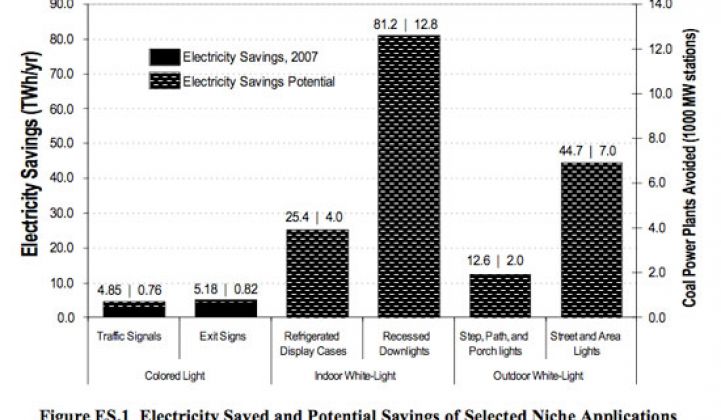The U.S. Department of Energy posted a comprehensive report on the LED lighting industry, and said that it is looking to invest in smart LED technologies.
Public policies and market forces (think high energy costs and global warming talks) have refocused the spotlight on what LED (light-emitting diode) technologies can do to save money and Mother Earth.
Like other types of greentech, energy-efficient lightings have been around for decades, but have only recently begun to reach the mass market.
Already, a small but growing number of industrial building operators and office complex managers are convinced that LED lights will save them money over long term and have installed them (see Sharp Turns On LED lighting Market).
The 104-page DOE report examined 12 niche markets where LEDs are grabbing market share from traditional lighting or are ready to do so soon. It found that LED lighting use saved power use by 8.7 trillion watt hours in 2007. In comparison, the most recent DOE estimates for all lighting energy use was 765 trillion watt hours in 2001.
"In addition to energy savings, LEDs can offer longer operating lifetimes (>50,000 hours), lower operating costs, improved durability, and improved color rendition. As LED technology advances - reducing costs and improving efficiency-LEDs will build market share in these and other niche markets," said the DOE in its report, which was prepared by Navigant Consulting in Washington, D.C.
By looking specifically at the top two markets for each of the colored light, indoor white light and outdoor white light products, the DOE found that actual and potential energy savings are equal to the output of roughly 27 coal-fired power plants with 1-gigawatt capacity each (see chart below).
Not surprisingly, LEDs are most commonly found in traffic signals, roadside signs and holiday lights. LEDs excel at shining specific colors of light efficiently for these products, and LEDs accounted for 82 percent of the exit-sign sector, and 52 percent of the traffic signal market in 2007. For holiday lights, LEDs picked up 5.2 percent of the market last year and carved out 6.1 percent of the electric signage segment.
The new frontier for LED lighting is indoors, said Navigant Consulting in the DOE report. Some of the next big markets will include retail displays, under-shelf office and kitchen cabinet lights.
Cost is still a barrier that stands in the way of LED's ability to grab large shares of the overall lighting market, particularly in the coveted home and office segments.
a">But some companies are leading the charge into the mass market. Philips Lighting, for example, is launching LED table lamps and other products. The lights, under the brand Ledino, would cost €69 ($107.56) per bulb. The company recently signed an agreement to license its LED technology to Osram.
LED evangelists say LED lighting might be expensive, but they use energy efficiently and last a long time, making them more desirable than incandescent and florescent lights.
Investors also are betting on the LED market. Luminus Devices in Billerica, Mass., raised $72 million in venture capital earlier this year (see Luminus Closes $72M to Light Up New Applications). Another startup, Nuventix in Austin, Texas, earlier this month raised $14 million to market its devices to cool LEDs (see Wakonda, Nuventix Raises Millions).
The market potential for LEDs also prompted lighting companies to swoop in and buy promising technologies. In July, Lighting Science Group bought Lamina Lighting (see Lighting Science Buys Lamina for $4.5M). In February, Cree (NSDQ: CREE) bought LED Lighting Fixtures (see Cree to Buy Firm Founded By Its Former Execs).
LEDs could do more than brighten our environment. Researchers at Boston University have developed the basic science for turning LED lighting into wireless data signals instead of using radio waves to carry data in a WiFi network.
The DOE is accepting LED research proposals through its 2009 Small Business Innovation Research program, which looks for technologies with commercial market potentials. Proposals are due on Nov. 20.



